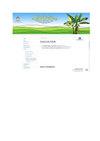特立尼达和多巴哥农民田间残留可可(Theobroma cacao L.)基因型选择
IF 0.3
Q4 AGRONOMY
引用次数: 0
摘要
特立尼达和多巴哥从18世纪起就有着悠久的可可种植历史,是公认的可可基因型遗迹的宝库。作为2009年至2011年期间进行的一个项目的一部分,该项目由世界银行开发市场、世界银行项目TF 093747(DM 2008)资助,从特立尼达和多巴哥各地的农场收集了106个假定的古老可可品种,以进行保护和利用,以保持传统的质量(风味)特征。本文的目的是提供在农民田间收集的94份“遗迹”材料的农艺和表型特征信息。这些被认为是克里奥洛斯或特里尼塔里奥斯的遗迹(选择于20世纪30年代前后),并在特立尼达和多巴哥的六个可可生产区中进行了选择。此外,还评估了特立尼达国际可可基因库(ICGT)保存的31份Trinitario可可区域材料的数据。根据22个表型性状对选择进行形态学评价,包括经济利益特征,即豆数(BN)、个体干豆重(DBW)、总湿豆重(TWBW)和荚指数(PI),其范围为26.4至58.0(CV16.3%);0.6g至2.12g(变异系数22.6%);42.5-228g(变异系数24.2%)和10-57(变异系数27.5%)。仅BN和DBW的生产区之间存在显著差异(p<0.0001)。相对于所研究的ICGT克隆,四个区域具有显著更高BN的选择,并且所有六个区域都具有更高TWBW的选择。没有发现子叶颜色和叶柄毛羽之间的关联,这表明这些性状的独立遗传用于在田间初步鉴定“Criollo样”基因型。来自多巴哥的FA通常具有更苍白的子叶,这意味着相对更明显的克里奥罗血统。基于主成分分析(PCA),主成分(PC)得分1和2占所研究材料在五个性状方面表达的表型变异的74.7%。PI和TWBW是PC 1的主要贡献者,而对于PC 2,主要贡献者是BN和DBW。主成分分析和聚类分析的结果表明,相对于所研究的ICGT类型,从农民的田地中收集了表型多样和独特的基因型选择,其中一些表现出“Criollo样”和Trinitario特征(大而饱满的种子/具有苍白子叶的豆子)和有利的产量潜力。这些可以用于增强ICGT的基因库,用于育种,将有利的Trinitario基因引入国家重复育种计划,并用于商业栽培。本文章由计算机程序翻译,如有差异,请以英文原文为准。
Selection of putative relic cacao (Theobroma cacao L.) genotypes in farmers’ fields in Trinidad and Tobago
Trinidad and Tobago is a repository of putative relic cacao genotypes, given its long history of cultivating cacao from the 1700s onwards. As part of a project conducted between 2009 and 2011, funded by the World Bank Development Market Place, World Bank Project TF 093747 (DM 2008), 106 putative, ancient cacao varieties were collected from farms throughout Trinidad and Tobago to be conserved and utilized to preserve traditional quality (flavour) attributes. The objective of this article is to provide information on agronomic and phenotypic traits of 94 of these 'relic' accessions collected in farmers' fields (FA). These are presumed to be relic Criollos or Trinitarios (selected pre-and post-1930s), and were selected over six cocoa production zones in Trinidad and Tobago. In addition, data for 31 regional Trinitario cacao accessions, which are conserved at the International Cocoa Genebank Trinidad (ICGT) were assessed. Morphological assessment of the selections was based on 22 phenotypic traits including characteristics of economic interest, viz. bean number (BN), individual dried bean weight (DBW), total wet bean weight (TWBW) and pod index (PI), which ranged from 26.4 to 58.0 (CV 16.3%); 0.6g to 2.12g (CV 22.6%); 42.5 to 228g (CV 24.2%) and 10 to 57 (CV 27.5%), respectively. Significant differences (p < 0.0001) were found among the production zones for BN and DBW only. Four zones had selections with significantly higher BN and all six had selections with superior TWBW relative to the ICGT clones studied. No association between cotyledon colour and leaf petiole hairiness was found, suggesting independent inheritance of these traits used for preliminary identification of 'Criollo-like' genotypes in the field. FAs from Tobago generally had selections with paler cotyledons, implying relatively more pronounced Criollo ancestry. Principal Component (PC) scores 1 and 2 accounted for 74.7% of the phenotypic variation expressed by the accessions studied in terms of five traits, based on Principal Component Analysis (PCA). PI and TWBW were major contributors to PC 1, while for PC 2, the major contributors were BN and DBW. The results of PCA and cluster analyses suggest that a phenotypically diverse and unique selection of genotypes was collected from the farmers' fields, relative to studied ICGT types, several of which displayed 'Criollo-like' and Trinitario characteristics (large, plump seeds/beans with pale cotyledons) and favourable yield potential. These can be utilized to enhance the genepool at the ICGT, for breeding to introgress favourable Trinitario genes into national recurrent breeding programmes and for commercial cultivation.
求助全文
通过发布文献求助,成功后即可免费获取论文全文。
去求助
来源期刊

Tropical Agriculture
Social Sciences-Development
CiteScore
0.50
自引率
0.00%
发文量
0
期刊介绍:
The overarching aim of Tropical Agriculture is to contribute to the process of agricultural development in tropical agro-ecosystems, through publication of papers in the area of agricultural science and technology. The specific objectives of the Journal are: -To address the practical aspects of sustainable tropical agriculture production, improvement, protection and commodity utilization, worldwide. -To foster the application of science and technology to understanding and removal of constraints to tropical agricultural productivity. -To publish the results of original research which make significant contributions to knowledge on the practice of sustainable and productive tropical agriculture. The Journal publishes papers in the following areas of tropical agriculture: -Soil Science and Technology -Environmental Science and Technology -Crop Science and Technology -Livestock Science and Technology as well as: Food and Nutrition Policy, Post-Harvest Technology, Agricultural Economics and Extension, Agribusiness
 求助内容:
求助内容: 应助结果提醒方式:
应助结果提醒方式:


